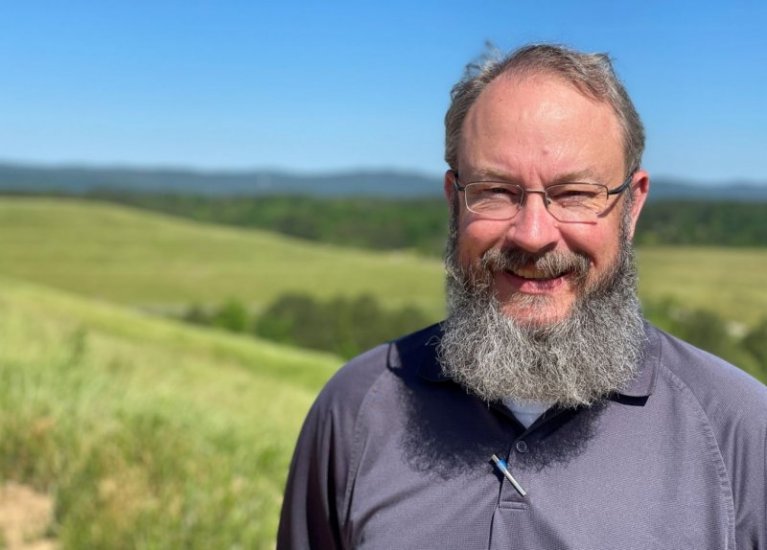Landfill Expansion Coming Later This Summer
 Wednesday, May 18th, 2022
Wednesday, May 18th, 2022
You might not spend much time thinking about where the garbage goes after you throw it out.
Don’t worry, Dirk Verhoeff and his crew at the Dalton-Whitfield Solid Waste Authority (DWSWA) think about it a lot. In fact, they’re getting ready to start construction on a new stage of the landfill to make sure our community still has plenty of room for that garbage for years to come.
“Our landfill is a 90-acre permitted site, and we have roughly 80 to 85 acres of that built out,” said Verhoeff, the DWSWA director. “We built stage 5 in 2018 and the stage 5 cell was 15 acres. Typically under normal tonnage rates that would last 7 to 9 years. But this one has filled up much quicker.”
At right: DWSWA Director Dirk Verhoeff in the landfill
Verhoeff explains that the landfill was starting to see higher tonnage rates even before the pandemic hit in 2020, but once COVID-19 pandemic began the landfill began to see even higher amounts of waste coming in.
“There are other factors at work, too. But we’re seeing record tonnage rates right now, almost 900 tons a day,” Verhoeff said, “where prior to the pandemic, we were at around 600, 700 tons a day.”
The DWSWA will start work on stage 6 of the landfill later this summer. The permitting, engineering, and design work for the project has already been completed. The master plan for the landfill’s development was mapped out in the 1990’s when the landfill was opened. The solid waste authority is currently taking bids for contractors to execute the plan to build stage 6, and proposals are due at the end of the month. Construction is expected to begin in July with an expected completion by the end of November.
“It’s a big job,” Verhoeff said. “There’s a lot involved, a lot more than people realize. People think that you just dig a hole and push it in.”
That doesn’t even begin to cover it. In a modern landfill, there are many layers of liner systems and safeguards that must be installed beneath a landfill section before it can be used to ensure contaminants from the garbage don’t find their way into the water system and damage the environment. The synthetic liner is installed with layers of natural clay and also non-woven geotextiles with a solid HDPE plastic liner on top. The sections of the liner are welded together to cover the seven acre site. A protective drainage layer of gravel goes on top of that.
“The construction quality assurance that goes into it is incredible,” Verhoeff said. “When they weld these panels together they have to go in and cut a section of that weld out and send it off for testing to ensure that weld is complete and adequate. Then they go back in and patch where they cut it out.
 “That’s just to ensure that the leachate, the rainwater that infiltrates and the moisture that’s already in the garbage, doesn’t get into the groundwater. All of the cells are sloped to one end, all of that liquid runs to the bottom to a sump and we pump it out of the cell floor and then it all goes to Dalton Utilities for treatment.”
“That’s just to ensure that the leachate, the rainwater that infiltrates and the moisture that’s already in the garbage, doesn’t get into the groundwater. All of the cells are sloped to one end, all of that liquid runs to the bottom to a sump and we pump it out of the cell floor and then it all goes to Dalton Utilities for treatment.”
The landfill isn’t just crucial for residents to have a place to put their garbage, it’s also essential to Dalton’s economy. With the floor covering industry and other manufacturing that takes place in our community, it’s vital that industry has a place for its solid waste to go.
At right: A closed section now is a steep, grassy hill rising over the access road
“With the heavy manufacturing that we have and obviously the carpet manufacturing and carpet waste, we see a lot of carpet waste, if they were having to transport that out of county or out of state it would lead to significant increases in their costs there,” Verhoeff said when asked about the DWSWA’s impact on the local economy. “There are other facilities that they could go to but they are getting further and further away which is more costly, obviously, for transportation. And their tipping fees are so much higher.
Once the landfill is completely built out over its permitted 90 acres, future expansion will go up, not out – as more layers are built on top of what currently exists. But eventually, time will be up.
“Right now, our expected life is about 15 to 16 more years which isn’t very long at all. This year we’re working with some consultants to look at what our options are,” Verhoeff said, noting that the DWSWA could expand the current permitted space laterally or vertically, or even start a new landfill at a new site.
Verhoeff has worked for the Dalton Whitfield Solid Waste Authority for nearly 15 years, coming to work in November 2007 after several years working in the private sector. Verhoeff, who has a degree in environmental engineering from UT-Chattanooga, worked first as an environmental manager before taking over as director of the department.
“It’s a lot of fun, it’s an interesting job. It’s very, very dynamic - there’s a lot of different things happening all the time, a lot of new challenges with a lot of new rule changes and regulations coming out constantly,” he said. “And I get to be outside, and work outside a lot, I’m not stuck behind a computer all day.”
